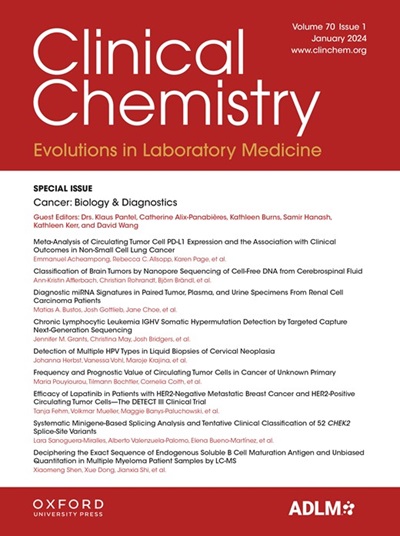A-083 在雅培 Alinity c 系统和 ARCHITECT c16000 系统上对哨兵诊断公司的 ACE 检测进行性能评估
IF 7.1
2区 医学
Q1 MEDICAL LABORATORY TECHNOLOGY
引用次数: 0
摘要
背景 在雅培 Alinity c 系统和 ARCHITECT c16000 系统上对血管紧张素转换酶(ACE)测定法的分析性能进行了评估,该测定法用于定量测定人血清和血浆中的血管紧张素转换酶活性。ACE(二肽基羧肽酶)是一种糖蛋白多肽水解酶,能从血管紧张素 I(一种相对无活性的十肽)中裂解组氨酰亮氨酸二肽。后者转化为强效血管收缩剂血管紧张素 II。ACE 还能使缓激肽失活。活动性肉样瘤病患者血清中的 ACE 活性水平会升高,患有呼吸窘迫综合征的早产儿、患有肺结核、戈谢病、麻风病的成人以及其他许多肺部和肝脏疾病患者的血清中的 ACE 活性水平也会偶尔升高。方法 ACE 会将尿丙烯酰苯丙氨酸-甘氨酰甘氨酸(FAPGG)水解为尿丙烯酰苯丙氨酸(FAP)和甘氨酰甘氨酸。FAPGG 的水解会导致 340 纳米波长处的吸光度下降。样品中的 ACE 活性是通过比较样品的反应速率和使用 Sentinel ACE 校准品获得的反应速率来确定的。性能评估是根据最新的 CLSI 指南协议进行的。结果 下表列出了测试化验的分析性能摘要。结论 圣天诺公司的 ACE 检测试剂盒的分析性能表明,在雅培 Alinity c 系统和 ARCHITECT c16000 系统上进行人体血清和血浆中 ACE 活性的定量测定适合常规检测。本文章由计算机程序翻译,如有差异,请以英文原文为准。
A-083 Performance evaluation of Sentinel Diagnostics’ ACE assay on the Abbott Alinity c system and ARCHITECT c16000 System
Background The analytical performances of the Angiotensin Converting Enzyme (ACE) assay for quantitative determination of ACE activity in human serum and plasma have been evaluated on the Abbott Alinity c system and ARCHITECT c16000 System. ACE (dipeptidyl carboxypeptidase) is a glycoprotein peptidyldipeptide hydrolase that cleaves histidylleucine dipeptide from angiotensin I, a relatively inactive decapeptide. The latter is converted to the potent vasoconstrictor, angiotensin II. ACE also inactivates bradykinin. Elevated levels of ACE activity occur in serum of patients with active sarcoidosis, and occasionally in premature infants with respiratory distress syndrome, in adults with tuberculosis, Gaucher’s disease, leprosy, and in many other pathologic conditions involving lung and liver diseases. Methods ACE hydrolyses urylacryloylphenylalanine-glycylglycine (FAPGG) to furylacryloylphenylalanine (FAP) and glycylglycine. Hydrolysis of FAPGG results in a decrease in absorbance at 340 nm. The ACE activity in the sample is determined by comparing the sample reaction rate to that obtained with the Sentinel ACE calibrator. Performances evaluation have been done following the latest CLSI guidelines protocols available. Results Summary of the analytical performances for the tested assay is reported in table below. Conclusions Analytical performances of Sentinel Diagnostics’ ACE assay demonstrate that quantitative determination of ACE activity in human serum and plasma are suitable for the routine measurement of the analyte on Abbott Alinity c system and ARCHITECT c16000 System.
求助全文
通过发布文献求助,成功后即可免费获取论文全文。
去求助
来源期刊

Clinical chemistry
医学-医学实验技术
CiteScore
11.30
自引率
4.30%
发文量
212
审稿时长
1.7 months
期刊介绍:
Clinical Chemistry is a peer-reviewed scientific journal that is the premier publication for the science and practice of clinical laboratory medicine. It was established in 1955 and is associated with the Association for Diagnostics & Laboratory Medicine (ADLM).
The journal focuses on laboratory diagnosis and management of patients, and has expanded to include other clinical laboratory disciplines such as genomics, hematology, microbiology, and toxicology. It also publishes articles relevant to clinical specialties including cardiology, endocrinology, gastroenterology, genetics, immunology, infectious diseases, maternal-fetal medicine, neurology, nutrition, oncology, and pediatrics.
In addition to original research, editorials, and reviews, Clinical Chemistry features recurring sections such as clinical case studies, perspectives, podcasts, and Q&A articles. It has the highest impact factor among journals of clinical chemistry, laboratory medicine, pathology, analytical chemistry, transfusion medicine, and clinical microbiology.
The journal is indexed in databases such as MEDLINE and Web of Science.
 求助内容:
求助内容: 应助结果提醒方式:
应助结果提醒方式:


